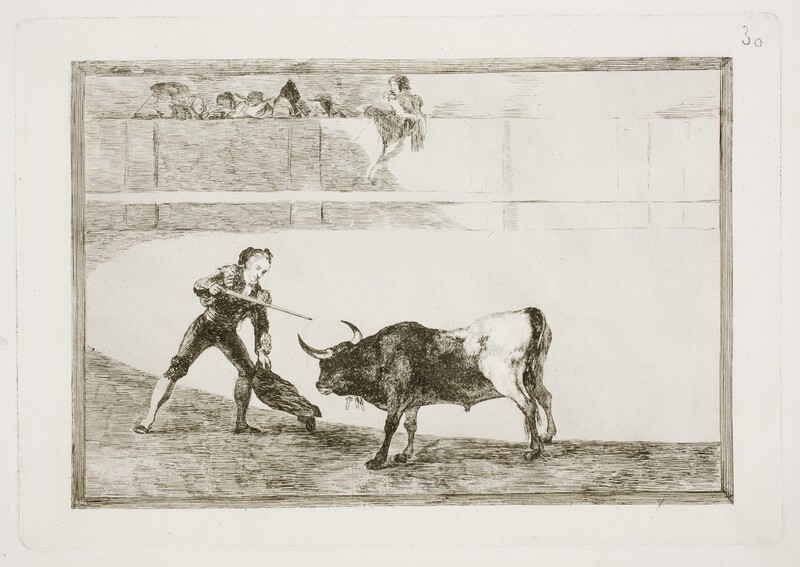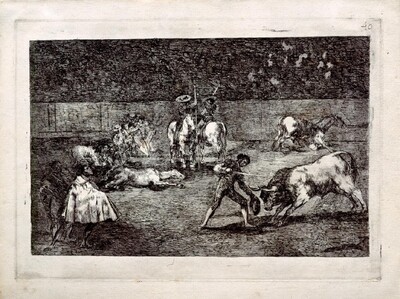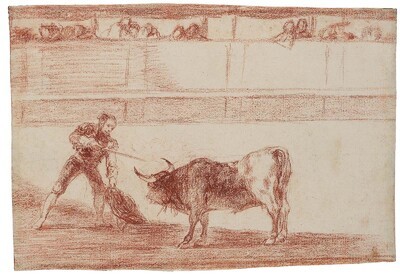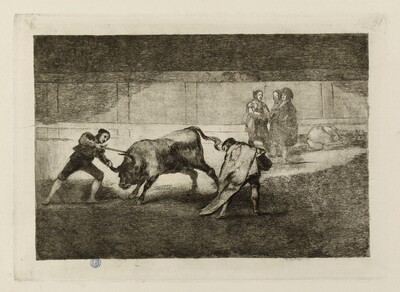- Cronología
- 1814 - 1816
- Dimensiones
- 245 x 354 mm
- Técnica y soporte
- Aguafuerte, aguatinta, punta seca y buril
- Reconocimiento de la autoría de Goya
- Documented work
- Ficha: realización/revisión
- 02 Oct 2021 / 22 Jun 2023
- Inventario
- -
- Otros títulos:
-
30 (print, upper right-hand corner)
See How the ancient Spaniards hunted bulls on horseback in the countryside
The plate is kept at the National Chalcography (nº 363).
See How the ancient Spaniards hunted bulls on horseback in the countryside
Scene devoted to Pedro Romero (1754-1839), one of the most admired bullfighters of Goya's time and his favourite. We see him on the left in the foreground, about to enter to kill the bull in front of him, which is logical, as the suerte de matar or suerte suprema was the one he mastered best and for which he was famous. Both the bullfighter and the bull are seen in profile, curiously illuminated between sun and shadow as they are positioned on the edge of the curved shadow cast by the unseen arena. In fact, one of the bullfighter's legs and the bull's hindquarter are powerfully illuminated because they are on this bullfighting frontier. In the background we see the barrier and some spectators behind it watching the bullfight covered with capes and hats to protect themselves from the sun.
Bagüés explains the suerte that the bullfighter is performing, a variant of the suerte de matar known as the suerte al volapié because the bullfighter entered very lightly to give the thrust. The position of the arm and the way of wielding the rapier reflect the imperfection of the technique, which had been invented a few years earlier by Costillares (1743-1800). In this connection, Lafuente Ferrari clarifies that the position of the bullfighter is not a mistake by Goya, but reflects the technical evolution of bullfighting, an opinion shared by Glendinning.
Lafuente Ferrari describes the print as sombre and at the same time luminous, clear, with a curved light that delimits the shadow in the sand and the framing of the bull and matador on the border between shadow and light. For Gassier, the sobriety of the print fits in with the sobriety of Pedro Romero's bullfighting, as this would be Goya's homage to his admired bullfighter. Martínez-Novillo, for his part, emphasises Goya's kind, affectionate and highly respectful treatment of Romero, depicting him at such a crucial and dignified moment as putting the bull to death.
Because of the luck depicted, the work is thematically related to two other prints by Goya linked to bullfighting which depict the luck of the kill or supreme luck: A bullfighter entering to kill with a hat in his hand instead of a muleta (Bullfighting I) and A bullfighter plunges the rapier into the bull by the horn (Bullfighting L).
There is a preparatory drawing of the present print, also entitled Pedro Romero killing a standing bull.
-
Grabados y dibujos de Goya en la Biblioteca NacionalBiblioteca NacionalMadrid1946catalogue Elena Páez Ríos
-
Goya en la Biblioteca Nacional. Exposición de grabados y dibujos en el sesquicentenario de su muerteBiblioteca NacionalMadrid1978May - June 1978
-
Grabados de Goya: colección propiedad de la Biblioteca Nacional, que se conserva en su Gabinete deCasa de la Amistad de MoscúMoscow1979exhibition displayed from January 18th to 31st 1979
-
1984
-
Madrid1987
-
Madrid1990
-
Goya grabadorFundación Juan MarchMadrid1994consultant editors Alfonso E. Pérez Sánchez and Julián Gállego, from January 14th to March 20th 1994
-
Goya grabadorMuseo del Grabado Español ContemporáneoMarbella1996from March 8th to May 5th 1996
-
Zaragoza1996
-
Ydioma universal: Goya en la Biblioteca NacionalBiblioteca NacionalMadrid1996from September 19th to December 15th 1996cat. 288
-
Schlaf der Vernunft. Original radierungen von Francisco de GoyaMunich2000
-
Madrid2002
-
Madrid2002
-
Bilbao2012
-
Goya: Order and disorderMuseum of Fine ArtsBoston2014cat. 100
-
Zaragoza2017
-
ZaragozaTip. del Hospicio1926p. 36
-
1946pp. 177-216, espec. pp. 204-205
-
BarcelonaTartessos-F. Oliver Branchfelt1946 (reed. 1951)
-
1961pp. 120-127
-
OxfordBruno Cassirer1964vol. II, 1964, p. 346, cat. 233
-
Vie et ouvre de Francisco de GoyaParísOffice du livre1970p. 279, cat. 1210
-
MilwakeeMilwaukee Art Museum1986pp. 20, 26-27 y 32
-
Goya, toros y torerosMadridMinisterio de Cultura, Comunidad de Madrid1990p. 113, cat. 46
-
MadridCaser-Turner1992pp. 20-21, 24, 28 y 36
-
Catálogo de las estampas de Goya en la Biblioteca NacionalMadridMinisterio de Educación y Cultura, Biblioteca Nacional1996cat. 355
-
Ydioma universal: Goya en la Biblioteca NacionalMadridBiblioteca Nacional, Sociedad Estatal Goya 96 y Lunwerg1996p. 254
-
MadridMuseo Nacional del Prado2001pp. 91-93
-
Goya: Order & DisorderBostonMuseum of Fine Arts Boston Publications2014p. 171
-
Goya. In the Norton Simon MuseumPasadenaNorton Simon Museum2016pp. 186-201



